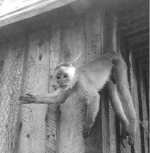
Snap Dragon
Scratch-Built Model Rocket
Part 6: Finalizing
Scratch-Built Model Rocket
Part 6: Finalizing
 |
Snap Dragon
Scratch-Built Model Rocket Part 6: Finalizing |
|
 |
Remember that second tube I made for a thrust ring way back when? It was 20 inches of posterboard rolled on a 1/2 inch dowel. Well this isn't it. I changed my mind. The reason is that we need a good way to mount the shock cord. The way it was done in the RS101 class may have contributed to the large number of ejection failures. I think this method will work OK. The new tube is made from 14 inches of posterboard just like the airframe. But instead of being rolled on a 3/4 inch dowel, it is rolled on a 1/2 inch rod. That makes it a loose fit in the airframe tube, and that is a good thing. I cut off an inch, and tie one end of an 18 inch length of shock-cord elastic around it. |
 |
This is plain old underwear-type elastic, 1/4 inch wide. It is available from any fabric store, craft shop, sewing department of a department store, or I guess you could cut some from the missus' undies, but I don't recommend it. The social repercussions could be dire. After tying the elastic, the tube is wrapped with another strip of posterboard, just enough to go around the tube one time plus a little overlap. I used green posterboard for the final wrap so you could see it. It was sprayed with Super 77 before wrapping, and is secured with rubber bands while the glue sets. |
 |
This should provide a smooth fit into the airframe tube, a solid bulkhead against which the motor will thrust, and a secure mounting for the shock cord. Too bad the shock cord is so close to the motor - it might get burned a bit upon ejection. Oh well. The shock cord elastic is run through the body tube, and is dangling out the nose end of the airframe. In a moment, I will put a big glob of Elmer's in the airframe, and use a spent motor casing to push the green thingy up to the right spot. |
 |
Did you catch that? I had to move quickly, and did not get a photo. But I did what I said, squirting a globular ring of Elmer's around the inside of the airframe tube at the fin end. Then I inserted the thrust ring tube, and used a spent Estes motor casing to push the tube forward about three inches. This leaves the nozzle of the Estes casing about 1/2 inch inside the tube. That is good. That's where we want it. But not for long. I find a stick, and push out the motor casing before the Elmer's has time to glue it in permanently, and make my potential rocket into a non-flying shelf ornament. |
 |
The thrust head has been pushed into place and the glue is allowed to set. Should be firm by now, so I'll launch it shortly. |
 |
Nose cone is tied to the shock cord, and a gaudy streamer added. My field is kinda small - models using parachutes sometimes don't come back. The streamer is simply surveyor's ribbon. It's primary virtues are that it is cheap and highly visible. |
 |
Here is an error to avoid: When inserting the nose cone, make sure the free end of the shock cord does not get pinched between the nose cone and the body tube. There were several ejection failures in my Rocket Science 101 class, and I think this is one of the reasons. The other is that we were using the traditional method of motor retention, wrapping the motor with masking tape until it was a tight fit. Not tight enough in some cases, so here is a better way: |
 |
Two small holes will be burned in the airframe tubing, just past the motor. A short section of stiff wire will be inserted, to prevent the motor from moving backwards upon ejection. After the glue has had a few minutes to dry, I put the casing back in and measure the depth from the end of the airframe. Using my rule of thumbs to mark the depth on the outside of the airframe, I will burn a hole here soon. |
 |
 |
OK, so I'm not really burning a hole in the second photo. Mostly, I'm taking a picture! This little tack loses heat very quickly, so if I'm distracted (which is likely!) it will cool down before I get around to using it. But I did it again after putting down the camera, and made a hole at the spot indicated. Then I made another one on the other side of the closest fin. |
 |
 |
Here's why. I'm going to use a piece of this paper clip for motor retention. |
 |
Spent casing is removed and replaced it with a live Estes motor. Paper clip is clipped, and I am bending the ends so it can't wiggle out. Since the motor is recessed, it's a lot easier to install the ignitor before putting it in the airframe. |
 |
Here it is on the launch pad, ready to go. Click here to see the launch (2 meg .wmv file, 27 seconds of highly compressed video) Summary: Successful launch, good recovery. It will fly again. |
 |
Jimmy Yawn Recrystallized Rocketry rev. 12/22/05 |
 |